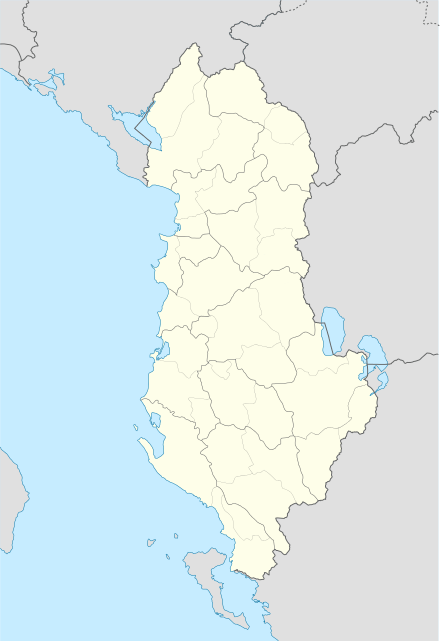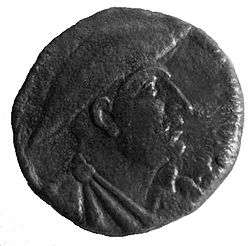Byllis
Byllis (Ancient Greek: Βύλλις) or Bullis or Boullis (Βουλλίς) was an ancient city located in the region of Illyria. The remains of Byllis are situated north-east of Vlorë, 25 kilometers from the sea in Hekal, Fier County, Albania.
Bylis (in Albanian) Βύλλις or Βουλλίς (in Greek) | |
 Ruins of Old Bylis | |
 Shown within Albania | |
| Location | Hekal, Fier County, Albania |
|---|---|
| Region | Illyria |
| Coordinates | 40.5403°N 19.7375°E |
| Type | Settlement |
| History | |
| Periods | Hellenistic, Roman, Byzantine |
| Cultures | Illyrian, Greek, Roman, Byzantine |
| Site notes | |
| Excavation dates | 1978–1991, 2000-present |
| Archaeologists | Camillo Prashniker, Neritan Ceka, Skënder Muçaj, Jean-Pierre Sodini, Pascale Chevalier, Nicolas Beaudry |
| Ownership | Public |
Cultural Monument of Albania | |
Stephanus of Byzantium mentions a town called Byllis as a seaside city in Illyria and its foundation legend, according to which the city was built by Myrmidons under Neoptolemus, returning from the Trojan War. This legendary tradition is reflected also by numismatics.[1]
The city was located on the territory of the Illyrian tribe of Bylliones.[2] The massive walls of Byllis were built before the end of the 4th century, and literary sources report them as an Illyrian rather than Epirote or Macedonian foundation.[3] Later Byllis acquired the trappings of a Hellenistic town,[3] and because the southernmost Illyrian tribes, including the Bylliones, were inclined to become bilingual, it was also a Greek-speaking city.[2] The Bylliones were first attested in the mid-4th century BC, in the description of the geographer Pseudo-Scylax,[4] and also asking the oracle of Dodona to which god they should sacrifice in order to ensure the safety of their possessions. The archaeological attestation of the city is possible as far back as the second half of the 4th century BC and was later conquered by Pyrrhus.[5]
Byllis received sacred Greek envoys, known as theoroi during the early 2nd century BC, which seems to indicate that it was a Greek city, or that its inhabitants had become Greek-speaking.[6]
The city
Byllis, being a Greek-speaking city,[2] on the borders of Illyria and Epirus, had its own stadium and theatre during the Hellenistic era.[7] About its foundation it has been suggested that Byllis was founded by Greek settlers.[8] The predominantly Greek character of the city is confirmed in the vast majority of the corpus of the names which mainly belong to the northern Greek onomastic area (Alexander, Andriscus, Archelaus, Kebbas, Maketa, Machatas, Nikanor, Peukolaos, Phalakros, Philotas, Drimakos and Alexommas) with an exception of a few Illyrian names (Preuratos, Triteutas, Trasos).[9][10] The city had its own coinage which was different from that of the tribe of the Bylliones.[11] M. B. Hatzopoulos believes that Byllis is the northernmost non-colonian Greek city in the region.[12] Fanula Papazoglou states that Byllis together with nearby Nikaia were "Greek foundations on barbarian territory".[13]
The walls of Byllis were 2,200m long, enclosing 30 hectares of a plain atop a hill 524m above sea level. There were 6 gates in the city walls. The road coming from Apollonia passed through two of them, crossing Byllis in the direction of the narrows of gorges of the Vjosa river on the way to Macedonia or those of Antigonia in the direction of Epirus. In 2011 during a road reconstruction near the archaeological park found in the site a statue of the Hellenistic era, which may depict an Illyrian soldier or a war deity, was discovered.[14] However, there is little point in proposing an Illyrian label for city in which language, institutions, officials, onomastics, city-planning and fortifications were Greek.[15]
.svg.png)

League of the Bylliones
The League (Koinon) of the Illyrian tribe of the Bylliones (Ancient Greek: Κοινὸν Βυλλίων), which had been hellenized to a degree and was bilingual,[16] was a coalition of one or two poleis,[17] as attested after 232 BC.[18] The league was restricted to Byllis and Nikaea,[19] and Byllis considered Nikaia as one of its demes.[17] Nikaia was a member of the league, as a 2nd-century BC inscription indicates.[20] The only attestation of the city as polis is in the work of Stephanus of Byzantium in the 6th century.[21] On the other hand, the citizens of Byllis were called Byllideis (Greek: Βυλλιδεῖς).[15]
Roman and Byzantine rule
Under the Roman Empire, Byllis became part of the province of Epirus Nova. Its name often occurs at the time of the civil wars.[22] In the time of Pliny the Elder, it was a Roman colony, and was called Colonia Bullidensis.[23] Its territory is called Bylliake (Βυλλιακή) by Strabo.[24] The walls of Byllis carry more than four inscriptions written in Greek with details regarding their construction by the engineer Victorinus, as ordered by Emperor Justinian I (483-565).[25][26]
During the early Christian period Byllis remained an important settlement in Epirus Nova though it was reduced in size. A significant number of basilica churches have been unearthed which contained mosaic floors and various carvings.[27] Two of those basilicas had possibly diaconicon chambers attached,[28] while a baptistery was established at basicila B.[29]
Association with see of Apollonia
One of the participants in the Council of Ephesus in 431 was a Felix who signed once as Bishop of Apollonia and Byllis, at another time as Bishop of Apollonia. Some assume that the two towns formed a single episcopal see, others suppose he was, strictly speaking, Bishop only of Apollonia, but was temporarily in charge also of Byllis during a vacancy of that see. At the Council of Chalcedon in 451, Eusebius subscribes simply as Bishop of Apollonia. In the letter of the bishops of Epirus Nova to the Byzantine Emperor Leo I in 458, Philocharis subscribed as Bishop of what the manuscripts call "Vallidus", and which editors think should be corrected to "Byllis". Whether Philocharis is to be considered Bishop also of Apollonia depends on the interpretation of the position of Felix in 431.[30][31][32]
The Annuario Pontificio lists Apollonia as a titular see, thus recognizing that it was once a residential diocese, a suffragan of the archbishopric of Dyrrachium.[33] It grants no such recognition to Byllis.[34]
See also
- List of ancient Cities in Illyria
- Tourism in Albania
References
Citations
- Ceka and Mucau (2005). Byllis. Tirana: Migjeni. p. 11. ISBN 99943-672-7-7.
- Tom Winnifrith. Perspectives on Albania. Macmillan, 1992. ISBN 978-0-333-51282-1, p. 37: The southernmost Illyrian tribes tended to become bilingual. Thus Byllis, the largest city in the territory of the Illyrian Bylliones, was a Greek-speaking city, visited by Greek envoys from the shrines of Greece.
- Winnifrith 2002, p. 58: "There are however, some other sites in Southern Albania which cannot be attributed to sudden Macedonian or Molossian advance, notably Amantia, Byllis and Selce, thought by some to be Pelium, where Alexander the Great fought a difficult campaign. Their massive walls were constructed before the end of the fourth century , and the literary sources talk of them as Illyrian rather than Epirote or Macedonian foundations. Later Amantia and Byllis acquired the trappings of a Hellenistic town."
- Pseudo-Scylax. Periplus, 27.
- Pyrrhus King of Epirus Petros Garouphalias
- Peter Allan Hansen. Carmina epigraphica Graeca. Novus Eboracus, 1983. ISBN 978-3-11-008387-3, p. 295: "Sacred envoys from Greek sanctuaries visited Greek cities only: Dyrrachium, Apollonia, Oricum, Amantia and Byllis (BCH 45 [1921], 1f.), from which it appears that Byllis was a Greek city, founded probably by Pyrrhus, or that its citizens, the Byllideis, had become Greek-speaking.".
- Tom Winnifrith. Badlands, borderlands: a history of Northern Epirus/Southern Albania. Duckworth, 2002. ISBN 978-0-7156-3201-7, p. 58
- Hammond 1989, p. 19
- Hatzopoulos, Sakellariou & Loukopoulou 1997, p. 144: "... the omasticon of Byllis , Nikaia and their regions consists of Greek names...This important testimony to the basically Greek character of the inhabitants is not invalidated by the presence of a few Illyrians names (Preuratos...)"
- Ceka & Muçaj 2005
- Hammond 1989, p. 18
- M. B. Hatzopoulos. The Borders of Hellenism in Epirus during Antiquity. Epirus: Ekdotike Athenon, p. 145, 1997.
- Hatzopoulos, Sakellariou & Loukopoulou 1997, p. 144: "Fanoula Papazoglou also speaks of "Greek foundations on barbarian territory"
- Fier: Ancient statue discovered in Byllis Archived 2016-03-04 at the Wayback Machine
- Hammond 1989, p. 17
- Marjeta Šašel Kos. Appian and Illyricum. Narodni muzej Slovenije, 2005, p. 226
- Pleket, H. W. Supplementum Epigraphicum Graecum, Volume XXXIX: 1989.
- Wilkes 1995, p. 97
- Robert, L. "Discours inaugaural", L' Illyrie méridionale et L'Épire dans l'Antiquité, Actes du colloque international de Clermont-Ferrand. Clermont-Ferrand, 1984 , p. 14.
- Hansen & Nielsen 2004, p. 346
- Bowden 2003
- e.g., Cicero, Phil. 11.11; Julius Caesar B.C. 3.40. et alii
- Pliny. Naturalis Historia. 4.10.17.
- Strabo. Geographica. vii. p.316. Page numbers refer to those of Isaac Casaubon's edition.
- Bowden 2003.
- Ceka and Mucaj (2005). Byllis. Migjeni. pp. 108–109. ISBN 99943-672-7-7.
- Chalkia, Eugenia (1997). "Early Christian Art". Epirus. Ekdotike Athenon: 166-81. ISBN 9789602133712.
A similar shrinkage occurred at Byllis ... was reduced to only 11 , but the town did not lose its importance , which is attested by the discovery of a great number of basilicas richly adorned with carving and mosaic floors.
- Chalkia, Eugenia (1997). "Early Christian Art". Epirus. Ekdotike Athenon: 166-81. ISBN 9789602133712.
"Among the southern annexes , an apsidal room with its own atrium stood apart and seems to have served as the diakonikon of the church , where the faithful deposited their offerings .
- Chalkia, Eugenia (1997). "Early Christian Art". Epirus. Ekdotike Athenon: 166-81. ISBN 9789602133712.
In basilica B at Byllis... the baptisteries take the form of a simple rectangular room on the south side of the church
- Daniele Farlati-Jacopo Coleti, Illyricum Sacrum, vol. VII, Venezia 1817, pp. 395-396
- Michel Lequien, Oriens christianus in quatuor Patriarchatus digestus, Parigi 1740, Vol. II, coll. 248-249
- Louis Petit, "Byllis" in Catholic Encyclopedia (New York 1908)
- Annuario Pontificio 2013 (Libreria Editrice Vaticana 2013 ISBN 978-88-209-9070-1), p. 835
- Annuario Pontificio 2013 (Libreria Editrice Vaticana 2013 ISBN 978-88-209-9070-1), "Sedi titolari", pp. 819-1013
Bibliography
- Beaudry, Nicolas (2010). 'Një punishte për prodhimin e verës në Bylisi', Monumentet 28, pp. 41–50.
- Beaudry, Nicolas, Chevalier, Pascale, & Muçaj, Skënder (2010). 'Le quartier épiscopal, campagne 2009, Byllis (Albanie)', Bulletin du Centre d’études médiévales d’Auxerre 14, pp. 57–60.
- Beaudry, Nicolas, et al. (2003). 'Byllis (Albanie)', Bulletin de correspondance hellénique 126.2, pp. 659–684.
- Bowden, William (2003). Epirus Vetus: The Archaeology of a Late Antique Province. Duckworth. ISBN 0-7156-3116-0.CS1 maint: ref=harv (link)
- Chevalier, Pascale, et al. (2003). 'Trois basiliques et un groupe épiscopal des Ve-VIe siècles réétudiés à Byllis (Albanie)', Hortus Artium Medievalium 9, pp. 155–165.
- Ceka, Neritan; Muçaj, Skënder (2005). Byllis, its history and monuments. Tirana.CS1 maint: ref=harv (link)
- Chevalier, Pascale, et al. (2008). 'Byllis (Albanie), campagne 2007: le quartier épiscopal, la Basilique E et les carrières', Bulletin du Centre d’études médiévales d’Auxerre 13, pp. 73–76.
- Chevalier, Pascale, Beaudry, Nicolas, & Muçaj, Skënder (2009). 'Le quartier épiscopal, campagne 2008, Byllis (Albanie)', Bulletin du Centre d’études médiévales d’Auxerre 13, pp. 73–76.
- Hammond, N. G. L. (1989). "The Illyrian Atintani, the Epirotic Atintanes and the Roman Protectorate". The Journal of Roman Studies. 79: 11–25. JSTOR 301177.
- Haxhimihali, Marin (2004). 'Byllis et sa région à la lumière des sources écrites du VIe siècle', L'Illyrie méridionale et l'Épire dans l'Antiquité IV, Paris, pp. 463–466.
- Hansen, Mogens Herman; Nielsen, Thomas Heine (2004). An Inventory of Archaic and Classical Poleis. Oxford University Press. ISBN 978-0-19-814099-3.CS1 maint: ref=harv (link)
- Hatzopoulos, M. B.; Sakellariou, M.; Loukopoulou, L. D. (1997). Epirus, Four Thousand Years of Greek History and Civilization. Ekdotike Athenon. ISBN 960-213-377-5.CS1 maint: ref=harv (link)
- Lewis, D. M.; Boardman, John (1994). The Cambridge Ancient History, Volume 6: The Fourth Century BC. ISBN 0-521-23348-8.CS1 maint: ref=harv (link)
- Wilkes, John (1995). The Illyrians. Wiley-Blackwell. ISBN 0-631-19807-5.CS1 maint: ref=harv (link)


